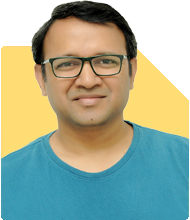Should I invest my PF in SWP after 3 years?
Milind Vadjikar | Answer |Ask -Follow
Insurance, Stocks, MF, PF Expert - Answered on Dec 07, 2024
He has a mechanical engineering degree from Government Engineering College, Sambhajinagar, and an MBA in international business from the Symbiosis Institute of Business Management, Pune.
With over 16 years of experience in stock investments, and over six year experience in investment guidance and support, he believes that balanced asset allocation and goal-focused disciplined investing is the key to achieving investor goals.... more

I’m 50 year old professional considering early retirement.. My current investments stand like this 50L in PF, 52L in NPS and another 50 lakhs in FD.. I hv a rent income of 20k and staying in own house.. my plan is investing 40 Lakhs from FD in to SWP withdrawing 40K per month. Balance 10L kept as Emergency fund Keep the NPS invested till I’m 60 later I can buy Annuity from that Is it good option to keep 52L that is in PF for next 3 years (till it earns interest) then I will consider to invest either in SWP or any other mutual funds Pls suggest any corrections needed to this? My monthly expenses will be around 50-60 k that can be met with above arrangement now and later considering inflation
To generate 40 K monthly income from 40 L fund you will have to do SWP at the rate of 12% which is unsustainable and not prudent.
Because an year of negative and/or flat returns in the market will erode the value of your corpus significantly.
Golden rule for SWP in retirement is that the source fund should be a hybrid fund with low allocation to equity and the SWP rate should not be more than 3-3.5%.
If you are keen to retire now you will have to withdraw the EPF so total corpus will be around 1 Cr.
A 3.5% SWP will yield you a monthly income of around 29.2 K.
Add your rental income of 20 K to this and your total monthly income comes to around 49.2 K.
If you do not wish to utilise your EPF now then you may have to continue working for atleast 5 years more.
Alternatively you may buy an immediate annuity for your corpus of 1 Cr and considering 6% annuity rate it may fetch you a monthly income of around 50 K but the flip side it is not indexed to inflation.
If you are confident of being able to top-up annuity income at 5, 10,15 year interval to match up with inflation then this can be a good option.
Best wishes;
You may like to see similar questions and answers below
Omkeshwar Singh | Answer |Ask -Follow
Head, Rank MF - Answered on Jan 07, 2022
Ramalingam Kalirajan |10899 Answers |Ask -Follow
Mutual Funds, Financial Planning Expert - Answered on May 18, 2024
Ramalingam Kalirajan |10899 Answers |Ask -Follow
Mutual Funds, Financial Planning Expert - Answered on May 11, 2024
Ramalingam Kalirajan |10899 Answers |Ask -Follow
Mutual Funds, Financial Planning Expert - Answered on May 21, 2024
Reetika Sharma |425 Answers |Ask -Follow
Financial Planner, MF and Insurance Expert - Answered on Dec 04, 2025
Ramalingam Kalirajan |10899 Answers |Ask -Follow
Mutual Funds, Financial Planning Expert - Answered on Dec 17, 2025
Ramalingam Kalirajan |10899 Answers |Ask -Follow
Mutual Funds, Financial Planning Expert - Answered on Dec 17, 2025
Ramalingam Kalirajan |10899 Answers |Ask -Follow
Mutual Funds, Financial Planning Expert - Answered on Dec 17, 2025
Ramalingam Kalirajan |10899 Answers |Ask -Follow
Mutual Funds, Financial Planning Expert - Answered on Dec 17, 2025
Ramalingam Kalirajan |10899 Answers |Ask -Follow
Mutual Funds, Financial Planning Expert - Answered on Dec 17, 2025
Mayank Chandel |2576 Answers |Ask -Follow
IIT-JEE, NEET-UG, SAT, CLAT, CA, CS Exam Expert - Answered on Dec 17, 2025
Radheshyam Zanwar |6747 Answers |Ask -Follow
MHT-CET, IIT-JEE, NEET-UG Expert - Answered on Dec 16, 2025
Shalini Singh |181 Answers |Ask -Follow
Dating Coach - Answered on Dec 16, 2025
Patrick Dsouza |1429 Answers |Ask -Follow
CAT, XAT, CMAT, CET Expert - Answered on Dec 16, 2025
Nayagam P P |10858 Answers |Ask -Follow
Career Counsellor - Answered on Dec 16, 2025




























